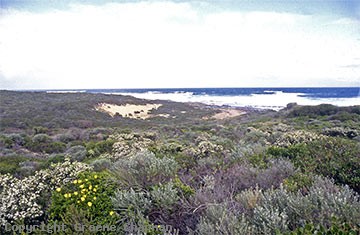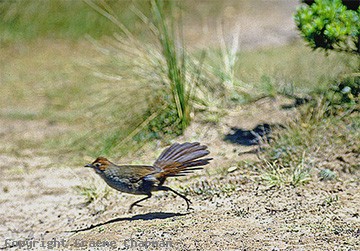Australian BirdsRufous Bristlebird (Western race)
|
GONE FOREVER? or AUSTRALIA'S RAREST PASSERINE
The western race of the Rufous Bristlebird once inhabited the windswept seaside heaths of the far SW of Western Australia between Cape Naturaliste and Cape Freycinet, a distance of only 65 km. Never an easy bird to find, it wasn't discovered until 1901 when Alex W Milligan collected the first specimen at Ellensbrook near Margaret River and described it in Vol. 1 of "The Emu", p. 67-69. Even then it took Milligan and his gun dog two days to get "a momentary glimpse of it" and four days before he could collect the specimen, a female which in mid-October showed no signs of breeding. Quite a few specimens were collected in the ensuing seven years or so, mainly by a colleague, C.P. Conigrave but only snippets of field notes survive. Milligan said the food consisted "wholly of landsnails". Tom Carter, at Ellensbrook in November 1902 said "a bird carrying its tail perpendicularly ran with immense speed across a patch of sand drift into a clump of bush" ; "on examination of its footprints in the fine sand, found them to be fairly evenly from 17 to 18 inches apart - a long stride for a bird of its size". By 1922 when Tom Carter visited the area again, the birds had all but disappeared from the places where they had once been. Writing in vol. 23 of "The Emu" he said "I revisited the same locality in March 1916, 1919 and 1922 where Mr Milligan and myself had seen these Bristlebirds in 1901 and 1902 respectively and found that where there had been dense, impenetrable scrub, was mostly sand drifts caused by fires made to improve the country for cattle grazing". In January and February of 1922 he spent six weeks systematically searching about twelve miles long of coastal scrubs without any result "often crawling on the ground underneath the scrub for long distances, watching, chirping and listening (also swearing)". Since that time the few records made have been inconclusive. A generally accepted observation was one made at The Fishing Place in March 1940 by the then Director of the W.A. Museum, Ludwig Glauert. In December 1977 whilst looking for tropicbirds at Sugarloaf Rock I heard a call from the low heath there only about 200 metres from the shore which I could attribute only to a bristlebird, but was unable to find it. In 1979, during field work for the Australian Atlas, a URRF (Unusual Record Report Form) was made for a "Brown Bristlebird" for the same area. A subsequent search by members of the W.A. Group of the RAOU failed to find anything. Later, in January 1980, another W.A. Group member, John Malone, took a photograph of a bird at the type locality, Ellensbrook, of a bird which he felt was a bristlebird but the image is too small to be conclusive. However, his clear description and field notes concerning this bird, and in particular that when running "the speed at which this bird moves has to be seen to be believed" refer without doubt to a bristlebird. Subsequent searches there and replay of the calls of eastern Rufous Bristlebirds have failed to disclose anything. The heath and adjoining shrubland both at Ellensbrook and Sugarloaf Rock now look ideal for Rufous Bristlebirds - there is no sign of the degradation described in the 1920's. Who knows, somewhere along that wild stretch of coastline a few birds might have survived in some pristine place. Presumably the W.A. birds were not blessed with the adaptability of their eastern counterparts which seem to be able to thrive in all manner of places seemingly spoilt by man. Unfortunately we don't know what the western ones sounded like but it seems unlikely they would differ greatly. Milligan described the song as "a series of clear, liquid, thrush-like notes" and the alarm call as " pink pink pink". The greatest difficulty I have encountered in that area, apart from that of access, is in overcoming the elements. Even on a fine day, the roar of the surf is sufficient to mask any distant sounds. Add to this the incessant calling "zeet zeet" of myriads of New-Holland Honeyeaters and you have a problem. |

921206 ... Heathland at the type locality Ellensbrook just west of Margaret River, now perfect habitat. |

921213 ... Rufous Bristlebirds run at great speed (photo taken in eastern Australia) |
